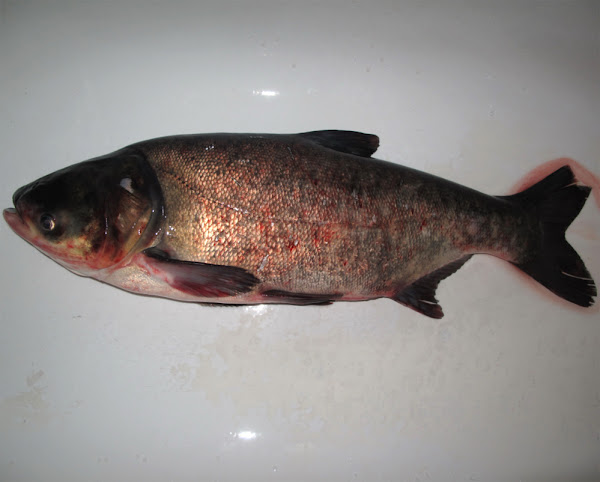The Bighead Carp fish is a species of freshwater fish, and one of the several Asian carps. It is native to the large rivers and associated floodplain lakes of eastern Asia.
It is one of the most intensively exploited fishes in aquaculture. Total production worldwide was recorded over 3 million tones in the year of 2013, principally from China.
Along with the availability in native area, range of the Bighead Carp fish extends from southern China north to Amur River system (which forms the border between China and Russia).
These species has also been introduced widely outside it’s native range (including the United States and many south Asian countries). Read some more information about this fish species below.
Bighead Carp Fish Characteristics
The Bighead Carp fish are similar in appearance to the Silver Carp fish, with main difference in body color. They generally have a mottled silver-gray body color. They have large, scaleless head with a large mouth. Eyes of these fish are located very low on the head. The belly keel extends forward from the vent only to the bases of the pelvic fins. The rakers on the first gill arch are long and slender.

The Bighead Carp fish can grow very large. They can generally reach 60 cm body length, with a maximum body length recorded around 140 cm. They can reach as much as 40 kg body weight. Photo and info from Wikipedia.
Feeding
The Bighead Carp fish are powerful filter-feeder with a wide food spectrum that grows fast and reproduce quickly. This specialty makes them a strong competitor.
They are generally fed on plankton and detritus strained from the water with their closely set gill rakers. As compared to Silver Carp fish, these fish eat larger plankton, including zooplankton and algae.
Breeding
Naturally in rivers, spawning is triggered by a rise in water level following rains. The spawning period of the Bighead Carp fish can extend from spring to late summer, apparently. The eggs are semibuoyant and are deposited into the river channel, and hatch as they are carried along in the river current.
These fish generally can’t successfully spawn in ponds or lakes. They generally reach maturity at their 3 years of age for females and 2 years for males. Although the exact age can vary significantly with changing environmental conditions. The female Bighead Carp fish can lay around 280,000 to 1.1 million eggs, and the eggs float for 40 to 60 hours before hatching.
Uses
These fishes are raised mainly for food. They are also used as a sportfish.
Special Notes
The Bighead Carp fish are economically very important fish species in aquaculture. It has the 5th-highest production of all cultured freshwater fish throughout the world with a production of around 7.5 percent.
It has a very fast growth rate, which makes it a lucrative aquaculture fish. And it is a very good fish species for commercial fish farming business. However, review full breed profile of this fish species in the chart below.
| Name | Bighead Carp |
| Kingdom | Animalia |
| Phylum | Chordata |
| Class | Actinopterygii |
| Order | Cypriniformes |
| Family | Cyprinidae |
| Genus | Hypophthalmichthys |
| Species | H. nobilis |
| Binomial Name | Hypophthalmichthys nobilis |
| Other Names | None |
| Breed Purpose | Mainly food, also sport fishing |
| Special Notes | Economically very important species, very popular throughout the world, has a very fast growth rate, very good for commercial production |
| Breeding Method | Natural and artificial |
| Weight | Usually grow 2-3 kg in commercial farms, but can grow up to 40 kg |
| Water Type | Freshwater |
| Climate Tolerance | Almost all climates |
| Body Color | Mottled silver-gray |
| Rarity | Common |
| Availability | Mainly Asia |





